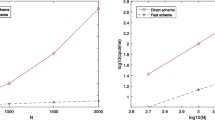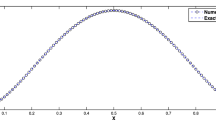Abstract
Two kinds of numerical schemes are investigated for time-fractional generalized Burgers’ equations (TFGBE). The first kind is obtained by the temporal second-order fast finite difference approach for the TFGBE with Dirichlet boundary conditions, and the second kind is obtained by the temporal second-order fast finite compact difference approach for TFGBE with periodic boundary conditions. In the time direction, both schemes employ nonuniform meshes to overcome the initial singularity, where the nonuniform Alikhanov formula with the sum-of-exponentials is used to approximate the time-fractional derivative. As a result, this allows the time direction to achieve second-order accuracy and saves a lot of computational costs. In the space direction, the classical second-order difference formulae are used to discretize the spatial derivatives in the finite difference scheme, which can arrive at second-order accuracy. The developed compact difference formulae are employed to approach the spatial derivatives in the compact difference scheme, which can allow the space direction to achieve fourth-order accuracy. For the two difference schemes, we carry out detailed theoretical analysis, including solvability, boundedness, and convergence analysis. In addition, we provide several numerical examples to test the effectiveness of the proposed fast difference/compact difference schemes and to verify the correctness of the theoretical analysis.





Similar content being viewed by others
Data Availability
The datasets are available from the corresponding author upon reasonable request.
References
Brio, M., Hunter, J.K.: Mach reflection for the two-dimensional Burgers equation. Phys. D Nonlinear Phenom. 60(1–4), 194–207 (1992)
Bouchaud, J.P., Mézard, M.: Velocity fluctuations in forced Burgers turbulence. Phys. Rev. E 54(5), 5116 (1996)
Laforgue, J.G.L., O’Malley, R.E., Jr.: Shock layer movement for Burgers’ equation. SIAM J. Appl. Math. 55(2), 332–347 (1995)
Sugimoto, N.: Burgers equation with a fractional derivative; hereditary effects on nonlinear acoustic waves. J. Fluid Mech. 225, 631–653 (1991)
Hopf, E.: The partial differential equation \(u_t+uu_x=\mu u_{xx}\). Technique report, Indiana Univ at Bloomington (1950)
Fletcher, C.A.J.: Generating exact solutions of the two-dimensional Burgers’ equations. Int. J. Numer. Methods Fluids 3, 213–216 (1983)
Hendy, A.S., Zaky, M.A., Tenreiro Machado, J.A.: On the Cole–Hopf transformation and integration by parts formulae in computational methods within fractional differential equations and fractional optimal control theory. J. Vib. Control 28(21–22), 3364–3370 (2022)
Qiu, W., Chen, H., Zheng, X.: An implicit difference scheme and algorithm implementation for the one-dimensional time-fractional Burgers equations. Math. Comput. Simul. 166, 298–314 (2019)
Peng, X., Xu, D., Qiu, W.: Pointwise error estimates of compact difference scheme for mixed-type time-fractional Burgers’ equation. Math. Comput. Simul. 208, 702–726 (2023)
Zhang, Q., Qin, Y., Wang, X., et al.: The study of exact and numerical solutions of the generalized viscous Burgers’ equation. Appl. Math. Lett. 112, 106719 (2021)
Guo, T., Xu, D., Qiu, W.: Efficient third-order BDF finite difference scheme for the generalized viscous Burgers’ equation. Appl. Math. Lett. 140, 108570 (2023)
Li, D., Zhang, C., Ran, M.: A linear finite difference scheme for generalized time fractional Burgers equation. Appl. Math. Model. 40(11–12), 6069–6081 (2016)
Sun, Z., Wu, X.: A fully discrete difference scheme for a diffusion-wave system. Appl. Numer. Math. 56(2), 193–209 (2006)
Lin, Y., Xu, C.: Finite difference/spectral approximations for the time-fractional diffusion equation. J. Comput. Phys. 225(2), 1533–1552 (2007)
Alikhanov, A.A.: A new difference scheme for the time fractional diffusion equation. J. Comput. Phys. 280, 424–438 (2015)
Brunner, H., Ling, L., Yamamoto, M.: Numerical simulations of 2D fractional subdiffusion problems. J. Comput. Phys. 229(18), 6613–6622 (2010)
McLean, W.: Regularity of solutions to a time-fractional diffusion equation. ANZIAM J. 52(2), 123–138 (2010)
Jin, B., Lazarov, R., Zhou, Z.: An analysis of the L1 scheme for the subdiffusion equation with nonsmooth data. IMA J. Numer. Anal. 36(1), 197–221 (2016)
Sakamoto, K., Yamamoto, M.: Initial value/boundary value problems for fractional diffusion-wave equations and applications to some inverse problems. J. Math. Anal. Appl. 382(1), 426–447 (2011)
Stynes, M., O’Riordan, E., Gracia, J.L.: Error analysis of a finite difference method on graded meshes for a time-fractional diffusion equation. SIAM J. Numer. Anal. 55(2), 1057–1079 (2017)
Chen, H., Stynes, M.: Error analysis of a second-order method on fitted meshes for a time-fractional diffusion problem. J. Sci. Comput. 79, 624–647 (2019)
Kopteva, N.: Error analysis of the L1 method on graded and uniform meshes for a fractional-derivative problem in two and three dimensions. Math. Comput. 88(319), 2135–2155 (2019)
Liao, H., Li, D., Zhang, J.: Sharp error estimate of the nonuniform L1 formula for linear reaction-subdiffusion equations. SIAM J. Numer. Anal. 56(2), 1112–1133 (2018)
Liao, H., McLean, W., Zhang, J.: A second-order scheme with nonuniform time steps for a linear reaction-subdiffusion problem. Commun. Comput. Phys. 30, 567–601 (2021)
Liao, H., Tang, T., Zhou, T.: A second-order and nonuniform time-stepping maximum-principle preserving scheme for time-fractional Allen–Cahn equations. J. Comput. Phys. 414, 109473 (2020)
Kopteva, N., Stynes, M.: A robust adaptive method for a quasi-linear one-dimensional convection–diffusion problem. SIAM J. Numer. Anal. 39(4), 1446–1467 (2001)
Liao, H., McLean, W., Zhang, J.: A discrete Gronwall inequality with applications to numerical schemes for subdiffusion problems. SIAM J. Numer. Anal. 57(1), 218–237 (2019)
Li, X., Liao, H., Zhang, L.: A second-order fast compact scheme with unequal time-steps for subdiffusion problems. Numer. Algorithms 86, 1011–1039 (2021)
Jiang, S., Zhang, J., Zhang, Q., et al.: Fast evaluation of the Caputo fractional derivative and its applications to fractional diffusion equations. Commun. Comput. Phys. 21(3), 650–678 (2017)
Guo, B.: A class of difference scheme for two-dimensional vorticity equations with viscous fluids. Acta Math. Sin. 17(4), 242–258 (1974)
Brunner, H.: The numerical solution of weakly singular Volterra integral equations by collocation on graded meshes. Math. Comput. 45(172), 417–437 (1985)
McLean, W., Mustapha, K.: Time-stepping error bounds for fractional diffusion problems with non-smooth initial data. J. Comput. Phys. 293, 201–217 (2015)
Sun, Z.: Numerical Methods of Partial Differential Equations, 2nd edn. Science Press, Beijing (2012)
Zhang, Q., Wang, X., Sun, Z.: The pointwise estimates of a conservative difference scheme for Burgers’ equation. Numer. Methods Partial Differ. Equ. 36(6), 1611–1628 (2020)
Song, K., Lyu, P.: A high-order and fast scheme with variable time steps for the time-fractional Black–Scholes equation. Math. Methods Appl. Sci. 46(2), 1990–2011 (2023)
Akrivis, G.D.: Finite difference discretization of the cubic Schrödinger equation. IMA J. Numer. Anal. 13(1), 115–124 (1993)
Li, S., Kravchenko, O.V., Qu, K.: On the \(L^\infty \) convergence of a novel fourth-order compact and conservative difference scheme for the generalized Rosenau-KdV-RLW equation. Numer. Algorithms 94, 1–28 (2023)
Dimitrienko, Y.I., Li, S., Niu, Y.: Study on the dynamics of a nonlinear dispersion model in both 1D and 2D based on the fourth-order compact conservative difference scheme. Math. Comput. Simul. 182, 661–689 (2021)
Acknowledgements
The authors are very grateful to the anonymous reviewers for their valuable suggestions which enhance the quality of this paper.
Funding
The authors have not disclosed any funding.
Author information
Authors and Affiliations
Corresponding authors
Ethics declarations
Conflict of interest
The authors declare that they have no known competing financial interests or personal relationships that could have appeared to influence the work reported in this paper.
Additional information
Publisher's Note
Springer Nature remains neutral with regard to jurisdictional claims in published maps and institutional affiliations.
Appendix: The Proof of Uniqueness for the Proposed Fast Difference Scheme (17)–(20)
Appendix: The Proof of Uniqueness for the Proposed Fast Difference Scheme (17)–(20)
To obtain the uniqueness result, we first invoke the following two lemmas.
Lemma A1
[33] For any grid function \(\phi \in \mathring{{\mathcal {V}}}_h\), there exists inverse estimate
In addition, by combing the third inequality of Lemma 2, we also have
Lemma A2
Suppose that \(\{ u_r^n, \phi _r^n\}\) is the solution of the fast difference scheme (17)–(20). Based on the conditions of Theorem 4, and if \(\rho \alpha \ge 2\), the spatial step \(h \le 1\) and the maximum temporal step \(\tau \) satisfies
then for any \(0\le n \le N\), we have
Proof
When \(\rho \alpha \ge 2\), then the inequality (44) becomes
and combing the inverse estimate and (A1), we have
When \(h\le 1\) and \(\frac{\tau ^2}{h}\le 1\) i.e., \(\tau \le \sqrt{h}\), we can get
Finally, we can obtain
This accomplished the proof. \(\square \)
Remark 4
It is worth noting that the assumption of \(\rho \alpha \ge 2\) is intended to be concise and easy to understand. Although \(\rho \alpha < 2\), we only need to adjust the restriction condition of the maximum temporal step \(\tau \le \root \rho \alpha \of {h}\), the conclusion of Lemma A2 also holds.
Proof of Theorem 2
Let \(\{ \tilde{u}^n,\;\tilde{\phi }^n \in \mathring{{\mathcal {V}}}_h \}\) and \(\{ \hat{u}^n,\;\hat{\phi }^n \in \mathring{{\mathcal {V}}}_h \}\) be the solutions of the fast difference scheme (17)–(20), respectively, then we have

and

For convenience, let
Now, subtracting (A7)–(A10) from (A3)–(A6), respectively. Then we get

where the definition of function g is same as (37). According to the differential mean value theorem, from (A12), we have
Furthermore, we have
Then, taking the inner product of (A11) with \(\bar{u}^{n-\sigma }\), we obtain
Now, we shall analyze the above equation term by term. Using the Lemma 5, we have
According to (A2), let \(\tilde{c}_0:=\max \limits _{0\le n \le N}\Vert \tilde{u}^n\Vert _\infty \). Using Lemmas 1–3 and Cauchy-Schwarz inequality, Young inequality, then we have
where \(c^\star \) is a positive constant, from which we use the fact, for any \(1\le r \le K-1\) and \(1\le n \le N\) that
in which, we only need to limit \(\tau /h \le 1\), i.e., \(\tau \le h\) we have \(|\varDelta _x\tilde{u}_r^{n-\sigma }|\le c^\star \). In addition,
Substituting the results of (A17)–(A19) into (A16), we have
Denote \(\tilde{c}_3:=\frac{2c^\star \tilde{c}_2}{p+2}+\frac{\tilde{c}_0^2\tilde{c}_2^2}{2\mu (p+2)^2}\), we have
We observe that the above inequality satisfies the conditions of Lemma 6, that is, \(v ^k=\Vert \bar{u}^k\Vert ,~\lambda _0=\tilde{c}_3\), \(\lambda _l=0\) for \(l\ge 1\), and \(\xi ^n=0\). Therefore, we can obtain by Lemma 6 that
However, \(\Vert \bar{u}^n\Vert \ge 0\). Thus, \(\Vert \tilde{u}^n-\hat{u}^n\Vert =0\). \(\square \)
Rights and permissions
Springer Nature or its licensor (e.g. a society or other partner) holds exclusive rights to this article under a publishing agreement with the author(s) or other rightsholder(s); author self-archiving of the accepted manuscript version of this article is solely governed by the terms of such publishing agreement and applicable law.
About this article
Cite this article
Peng, X., Qiu, W., Hendy, A.S. et al. Temporal Second-Order Fast Finite Difference/Compact Difference Schemes for Time-Fractional Generalized Burgers’ Equations. J Sci Comput 99, 52 (2024). https://doi.org/10.1007/s10915-024-02514-4
Received:
Revised:
Accepted:
Published:
DOI: https://doi.org/10.1007/s10915-024-02514-4




